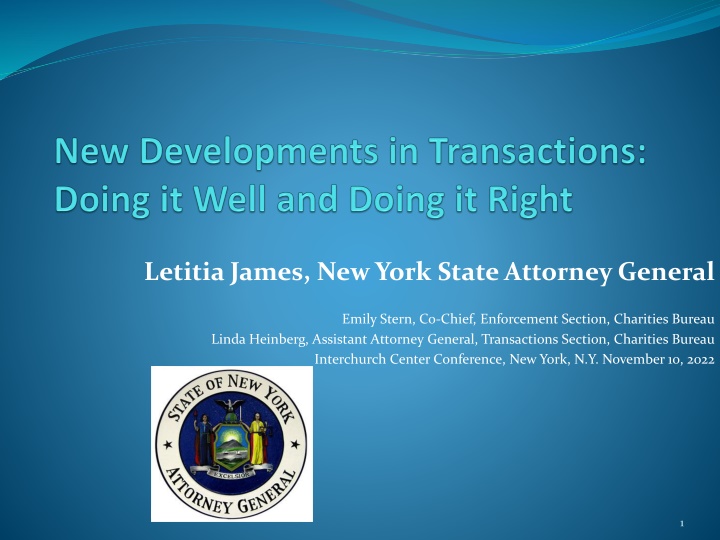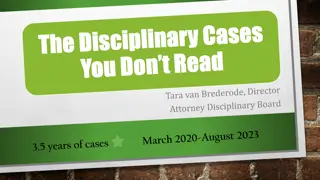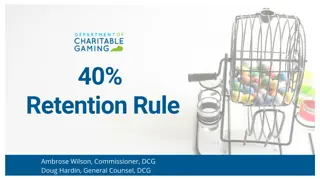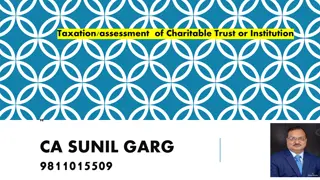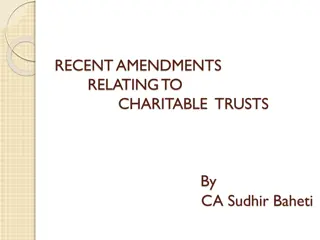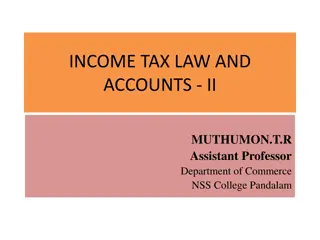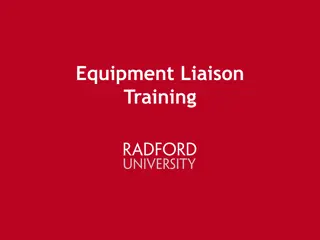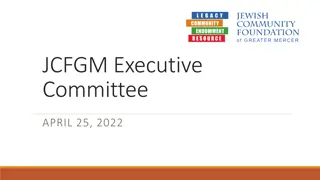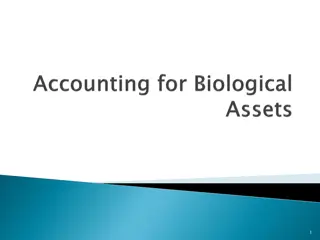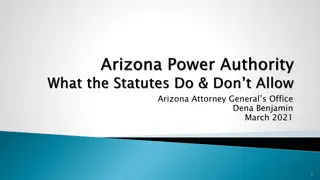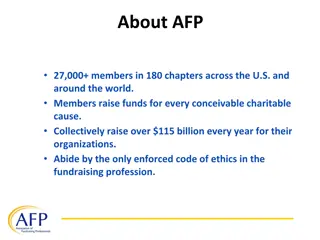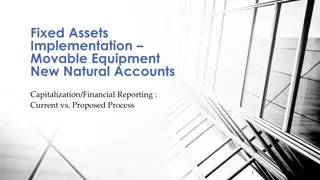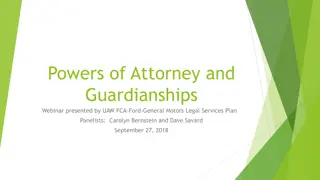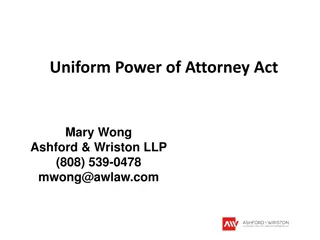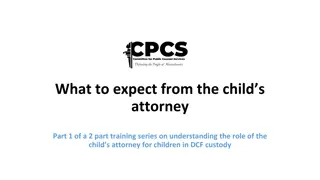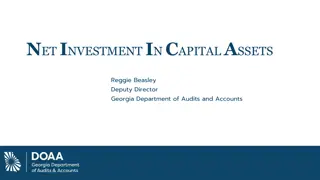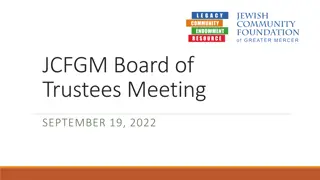The Role of New York Attorney General in Protecting Charitable Assets
New York State Attorney General plays a crucial role in safeguarding charitable assets, especially religious real property. This involves ensuring compliance with statutory standards, preventing self-dealing, and protecting charities from unfair transactions. Fiduciary responsibilities of trustees and governance personnel are also emphasized to maintain trust and proper administration of charitable assets.
Download Presentation

Please find below an Image/Link to download the presentation.
The content on the website is provided AS IS for your information and personal use only. It may not be sold, licensed, or shared on other websites without obtaining consent from the author.If you encounter any issues during the download, it is possible that the publisher has removed the file from their server.
You are allowed to download the files provided on this website for personal or commercial use, subject to the condition that they are used lawfully. All files are the property of their respective owners.
The content on the website is provided AS IS for your information and personal use only. It may not be sold, licensed, or shared on other websites without obtaining consent from the author.
E N D
Presentation Transcript
Letitia James, New York State Attorney General Emily Stern, Co-Chief, Enforcement Section, Charities Bureau Linda Heinberg, Assistant Attorney General, Transactions Section, Charities Bureau Interchurch Center Conference, New York, N.Y. November 10, 2022 1
NEW YORK ATTORNEY GENERAL TISH JAMES
So, you want to transfer your property: Doing it Well and Doing it Right Role of the AG Statutory Standards Fiduciary Responsibilities Cautionary Tale: When a Transaction becomes an Enforcement matter Doing it Well
Role of the Attorney General Attorney General James is committed to supporting and protecting the faith-based community. Statutory responsibility to protect charitable assets, including religious real property, as well as the charitable beneficiaries. Assure compliance with procedural requirements Prevent self-dealing, private inurement, private benefit Protect charities from unfair, unenforceable or one- sided transactions
Statutory Standards N.Y. Religious Corporation Law and N.Y. Not-for-Profit Corporation Law require either Court or AG approval for the sale, mortgage or leasing (for over 5 yrs) of religious real property. Standards for approval: the consideration and the terms of the transaction are fair and reasonable to the corporation and the purposes of the corporation or the interests of the members will be promoted Use of Proceeds 5
Statutory Standards The purpose of this requirement is to protect the members of the religious corporation, the real parties in interest, from loss through unwise bargains and from perversion of the use of the property. St. Lucy's Cathedral Old Roman Cath. Church v. Sacred Heart of Jesus Eng. Rite Cath. Church, Inc., 189 A.D.3d 909, 911, (2d Dep t 2020) (quoting Church of God of Prospect Plaza v. Fourth Church of Christ, Scientist, of Brooklyn, 76 A.D.2d 712, 716 (2d Dep t 1980), affd 54 N.Y.2d 742 (1981)). 6
Fiduciary Responsibilities Trustees or persons responsible for the governance of religious charities have duties codified by statute: to discharge their respective positions in good faith and the care an ordinarily prudent person in a like position would exercise under similar circumstances. N.Y. Not-for-Profit Corporation Law 717 to properly administer the charitable assets of the organization. N.Y. Estates, Powers & Trusts Law 8-1.4(m) not to self-deal, including by engaging in related party transactions without disclosure to and approval by the majority of independent members of the governing body of the charity. N.Y. Not-for Profit Corporation Law 715 and EPTL 8-1.9 7
How Does this Apply: Consider a Cautionary Tale The AG commenced a confidential investigation in late 2017 into seven development projects involving church- owned properties in Harlem and Brooklyn with Moujan Vahdat, a developer. These transactions went unfinished and/or were past due for many years. Each of these deals had been subject to AG review and were approved by the AG or the Court based on representations made by senior clergy. The investigation was extensive and entailed review of voluminous records, including emails and text messages between the parties, bank records, testimonial examinations, and interviews with numerous witnesses. 8
The Attorney Generals Core Factual Findings Documentary and Testimonial Evidence showed that: Mr. Vahdat had undisclosed financial relationships with senior clergy, who had responsibilities for negotiating, overseeing, and in some instances, approving the development deals with Mr. Vahdat. Mr. Vahdat gained favor by making donations to the churches He then gave clergy fees as finders and gifts while negotiating and after securing deals. One cleric received more than $600,000 and another received more than $300,000. 9
The Attorney Generals Core Factual Findings Mr. Vahdat bestowed significant payments and gifts on the senior clergy while the clergy were responsible for selecting developers, negotiating transactions, seeking necessary court or administrative approvals, and overseeing compliance with the deal terms. The financial transactions between the clergy and the developer created conflicts of interest and constituted related party transactions. However, the clergy did not, as required by law, provide advance disclosure and obtain a approval of the transactions as fair, reasonable and in the best interests the church by its governing body. 10
The Attorney Generals Core Factual Findings The clergy allowed the developer to alter or amend protections in the deals, which put churches in vulnerable positions and which were not presented to the AG or Court for approval. The clergy s financial relationships with Mr. Vahdat were also not disclosed, as required, to the AG or the court. 11
The Attorney Generals Core Legal Findings The clergy breached their fiduciary duties to the churches in violation of their statutory obligations. Mr. Vahdat and clergy violated New York law by engaging in undisclosed, unapproved related-party transactions. 12
The Outcome of the Investigation The AG reached settlements with Bishop Gregory Ingram and Reverend Melvin Wilson requiring: Financial restitution to their churches Permanent bars on serving in a fiduciary role in any New York charity or not-for-profit, or from administering charitable assets in New York. (This does not relate to positions that are purely spiritual or ministerial.) The AG filed a civil enforcement action in NYS Supreme Court against Bishop Kevin Griffin, who is challenging the AG s claims. 13
The Outcome of the Investigation The AG reached a settlement with Mr. Vahdat and his related business entities requiring him to make restitution to the churches. 14
Structure of the Transactions at Issue The structures of the deals in the AG Investigation resulted in the developer holding title to the properties before he had to perform in full. Development deals in which organization received small amount of $ at closing, promise of new church space (sanctuary, offices, classrooms, parsonage, etc.) and future cash flow. Ground Lease Sale and Leaseback w/promise of renovations 15
Remedial Options The AG fashioned a choice of remedial options Monitored Performance Option: Developer to complete project as originally promised under supervision of a Third- Party Project Monitor and the AG s office. Cash-Out Option: Developer paid the church cash based on original value of property; developer keeps title to the property. Ground lease: lease could be canceled, and the property conveyed to the developer in exchange for the cash. Rescission Option: Property could be deeded back to the church free and clear of liens; church then free to sell, build, lease or mortgage it. 16
Monitored Performance Option Considerations: Size and type of facility contracted for; will it work today and future? Agreement reached on specifications? Costs associated w/maintaining the facility: heating, cooling, electricity, sewer and water charges and condo fees. White box or finished? Budgets/funds for furniture, fixtures and equipment; sound system, pews etc.? Value: how many sq ft promised and how much will developer spend? In other words, how much is it worth? Timing: multiple year projects. What will be built upstairs, will it provide the residual income contracted for? (zoning). 17
Cash Out Option Considerations: What to do w/the $? Where will you worship? Buy, lease, virtual services? Is it enough $? Evaluate value: how does the combination of what was received at closing and the offered cash out amount compare to the current property value? 18
Rescission Option Considerations: cash or cash equivalents means cash and payment of debts; does the church have cash on hand for the payback? What to do w/the property if returned; risk/time associated w/building or selling. Evaluate value: compare current property value. 19
Doing it Well Title transfer simultaneous w/closing of developer financing for entire development. Safeguards for nonperformance: letters of credit, payment and performance bonds before demolition, deed covenants/reversions, late fees must turn into defaults; default upon bankruptcy. Arm s length relationships among developer, clergy, Trustees, congregants and advisors such as brokers and appraisers. 20
Doing it Well Bring full Board and congregation into the conversations (transparency). Retain qualified professional advisors; reasonable fees. Discuss, determine and document goals and objectives. Identify and document issues and potential roadblocks. 21
Doing it Well Obtain an independent appraisal. Maintain up to date financial statements Conduct due diligence on counterparties. Confirm that relationships with counterparties are arms-length Plan for the use of the proceeds of the transaction and accurately explain in petition 22
Our detailed transaction guides Asset Sales https://www.charitiesnys.com/pdfs/sales_and_other_ dispositions_of_assets.pdf https://charitiesnys.com/pdfs/religious_corporations_ disposition_assets.pdf https://www.charitiesnys.com/pdfs/AppraisalGuidanc e.pdf 23
Resources New York Charities Bureau guidance https://www.charitiesnys.com/guides Right From the Start - Responsibilities of Directors of Not-for-Profit Corporations Internal Controls and Financial Accountability for Not- for-Profit Boards Whistleblower Policies Under the Nonprofit Revitalization Act of 2013 Accounting from the Inside Out Internal Controls and External Accountability (New York Council of Nonprofits) 24
